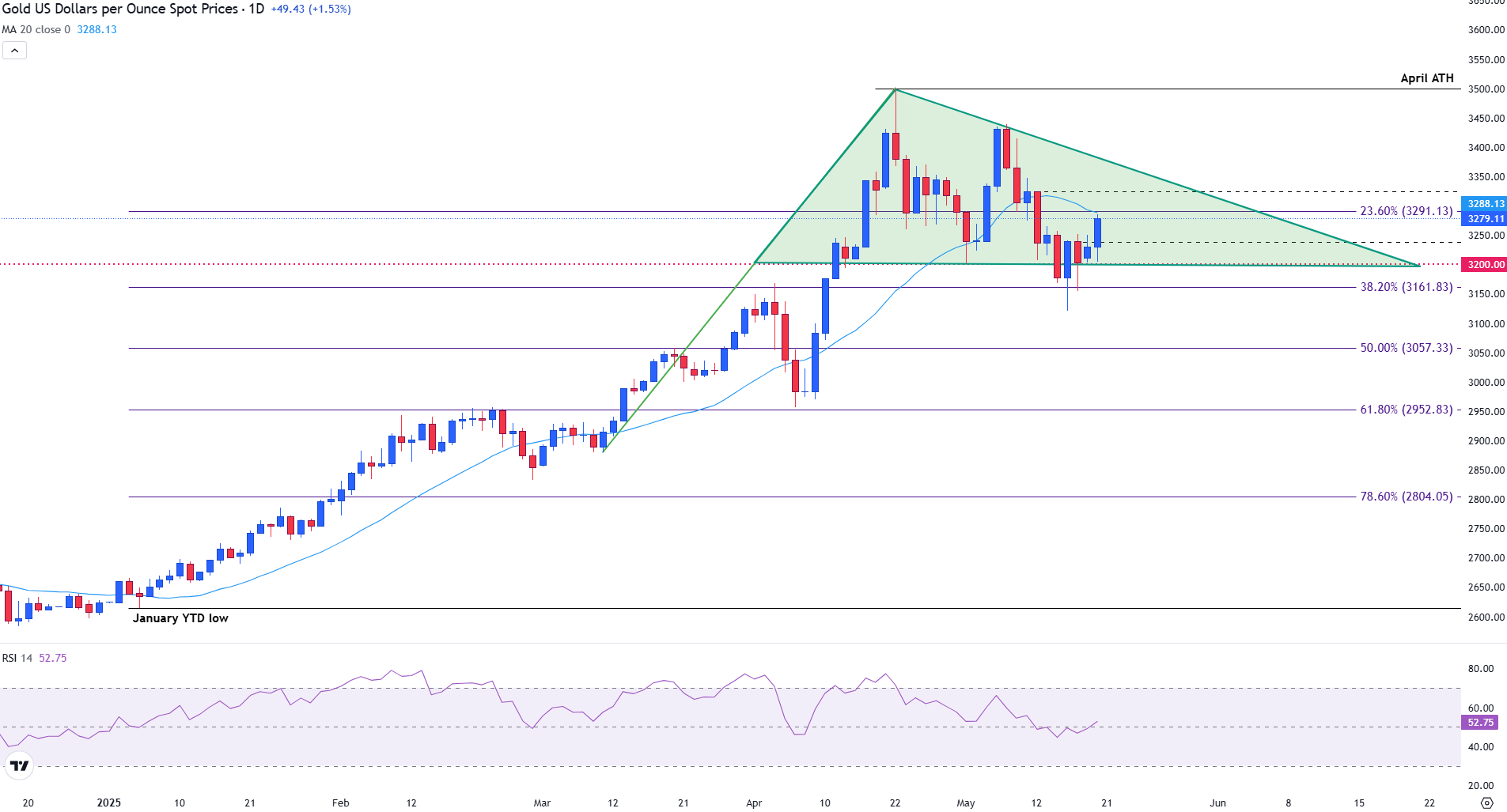Gold rises as USD weakens and fiscal risks lift safe-haven demand
- Gold extends gains on Tuesday, buoyed by broad-based US Dollar weakness and safe-haven demand.
- Moody’s downgrade of US sovereign debt and renewed fiscal concerns continue to support bullion prices.
- XAU/USD trades near $3,280, holding within a symmetrical triangle structure and testing key resistance at the 20-day SMA.
- Market sentiment remains cautious, with investors closely watching Wednesday’s House vote on Trump’s “One Big Beautiful” tax bill.
Gold (XAU/USD) prices are surging on Tuesday, buoyed by broad-based US Dollar weakness and renewed concerns over the United States’ fiscal health following Friday’s Moody’s downgrade of US sovereign debt.
The safe-haven metal is extending its rally from Monday, supported by deteriorating growth prospects for the world’s largest economy. Gold bulls are now eyeing the key psychological threshold of $3,300, with the metal up 1.51% to trade near $3,280 at the time of writing.
While gains have been somewhat tempered by a rebound in US Treasury Yields and a mutual reduction in tariffs between the US and China, shifting global trade dynamics and persistent policy uncertainty continue to provide a supportive backdrop for bullion.
Looking ahead, Wednesday’s House of Representatives vote on President Donald Trump’s “One Big Beautiful” tax bill, along with evolving expectations for Federal Reserve policy, are expected to play a pivotal role in shaping short-term Gold price action.
Gold (XAU/USD) bounces off support with $3,300 back in focus
Gold (XAU/USD) is attempting a rebound on Tuesday, climbing over 1.5% to trade near $3,280 as it tests the upper boundary of a symmetrical triangle pattern formed since the April all-time high.
The price is approaching both the 20-day Simple Moving Average (SMA) at $3,288 and the 23.6% Fibonacci retracement level of the January to April YTD move at $3,291.
Despite recent downside pressure, the $3,200 support level has held firm, reinforcing the triangle’s lower boundary and suggesting strong buyer interest near this zone.
The Relative Strength Index (RSI) remains neutral around 52.84, indicating a lack of clear momentum bias for now.
Gold (XAU/USD) daily chart

A breakout above $3,291 would signal bullish continuation and could open the path toward retesting the record high, while a break below $3,200 would invalidate the structure and expose deeper Fibonacci support levels at $3,161 and $3,057.
Gold FAQs
Gold has played a key role in human’s history as it has been widely used as a store of value and medium of exchange. Currently, apart from its shine and usage for jewelry, the precious metal is widely seen as a safe-haven asset, meaning that it is considered a good investment during turbulent times. Gold is also widely seen as a hedge against inflation and against depreciating currencies as it doesn’t rely on any specific issuer or government.
Central banks are the biggest Gold holders. In their aim to support their currencies in turbulent times, central banks tend to diversify their reserves and buy Gold to improve the perceived strength of the economy and the currency. High Gold reserves can be a source of trust for a country’s solvency. Central banks added 1,136 tonnes of Gold worth around $70 billion to their reserves in 2022, according to data from the World Gold Council. This is the highest yearly purchase since records began. Central banks from emerging economies such as China, India and Turkey are quickly increasing their Gold reserves.
Gold has an inverse correlation with the US Dollar and US Treasuries, which are both major reserve and safe-haven assets. When the Dollar depreciates, Gold tends to rise, enabling investors and central banks to diversify their assets in turbulent times. Gold is also inversely correlated with risk assets. A rally in the stock market tends to weaken Gold price, while sell-offs in riskier markets tend to favor the precious metal.
The price can move due to a wide range of factors. Geopolitical instability or fears of a deep recession can quickly make Gold price escalate due to its safe-haven status. As a yield-less asset, Gold tends to rise with lower interest rates, while higher cost of money usually weighs down on the yellow metal. Still, most moves depend on how the US Dollar (USD) behaves as the asset is priced in dollars (XAU/USD). A strong Dollar tends to keep the price of Gold controlled, whereas a weaker Dollar is likely to push Gold prices up.

